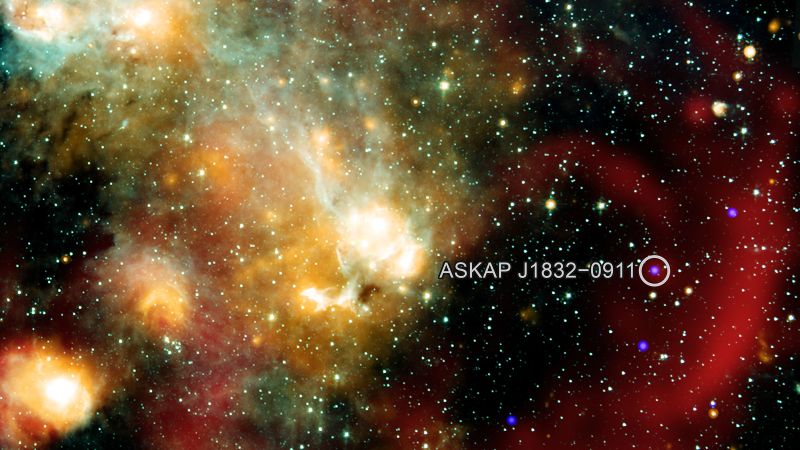In an intriguing development in the field of astrophysics, astronomers have recently discovered an extraordinary celestial object emitting bright flashes of radio waves and X-rays, which last for two minutes and recur every 44 minutes. This discovery marks a significant milestone, as it represents the first known instance where powerful X-rays have been linked to a potentially long-period transient—an exotic class of astronomical objects. The first hints of this mysterious new category emerged in 2022, but fewer than twelve such objects have been identified in total thus far.
Dr. Andy Wang, an associate lecturer at the Curtin Institute of Radio Astronomy in Australia, noted the peculiarities of long-period transients (LPTs), which emit bursts of radio waves at intervals ranging from minutes to hours. Wang emphasized that the nature of these phenomena—and the mechanisms that drive their peculiar emissions—remain largely shrouded in mystery. The newly identified object, named ASKAP J1832-0911, is situated approximately 15,000 light-years away from Earth, residing within the same galaxy as our solar system.
The X-ray emissions captured by NASA’s Chandra X-ray Observatory may provide fundamental insights into the characteristics of these enigmatic cosmic objects and their distinctive pulsing behavior. According to Wang, the presence of X-rays typically indicates extremely hot and energetic environments, which suggests that some dramatic events have unfolded in association with this object. The study detailing these findings was published in the prestigious journal Nature, with Wang as the lead author.
Wang also revealed that the presence of X-rays could indicate that long-period transients are more energetic than previously thought, demonstrating a capability to produce X-rays—radiation that carries more energy than radio waves. As researchers delve deeper into the origins of ASKAP J1832-0911’s emissions, they face the challenge of fitting these findings into existing categories of celestial objects. Initial theories considered whether the object might be a magnetar—a dense remnant of a star with an immensely powerful magnetic field—or a binary star system inclusive of a highly magnetized white dwarf. However, these theories have yet to fully account for the observed emissions.
“This object is unlike anything we have seen before,” Wang stated, hinting that this discovery could hint at new physics or alter existing models of stellar evolution. In a previous study, astronomers traced another long-period transient to a white dwarf orbiting a smaller and cooler red dwarf star. The close interaction of these two stars was responsible for the emitted long radio bursts, but the team did not observe similar signals from ASKAP J1832-0911.
Charlie Kilpatrick, a research assistant professor at Northwestern University, characterized the new find as “exciting”, noting that it highlights the extreme nature of compact astronomical objects. The characteristics of ASKAP J1832-0911 suggest it occupies a unique space between extreme magnetars and white dwarfs, challenging astronomers to rethink their understanding of such entities.
Looking ahead, Wang anticipates that future X-ray observations could reveal critical information about the object’s temperature and size, further clarifying its classification. The Australian Square Kilometre Array Pathfinder (ASKAP)—which conducts regular sky scans—is pivotal to this research. The team first detected the vivid signals from ASKAP J1832-0911 in December 2023, and later identified exceptionally bright pulses in February 2024, classifying them among the few known instances of such brightness in radio emissions.
Notably, the coincidental timing of the Chandra X-ray Observatory’s observations during a bright phase of ASKAP J1832-0911 demonstrated an exemplary stroke of fortune—a fortunate case of “finding a needle in a haystack”, as Wang aptly described. Unlike pulsars, which exhibit radio pulses lasting milliseconds, ASKAP J1832-0911’s emissions reveal a unique pattern of intensity variation every 44 minutes, making it all the more intriguing.
The research team employed the recently developed CRACO (Coherent Radio Astronomy Core) instrument, designed to detect fast radio bursts and long radio pulses, contributing to the ongoing quest to categorize the fascinating celestial phenomena. With advances in technology and critical international collaboration, the study of ASKAP J1832-0911 opens a new chapter in understanding long-period transients, suggesting that this discovery is merely the tip of the iceberg in uncovering numerous other similar astronomical objects. Dr. Nanda Rea, a professor at the Institute of Space Science and the Institute of Space Studies of Catalonia in Spain, underscored this potential, asserting that the transient X-ray emissions have indeed opened fresh avenues of inquiry into the nature of such cosmic enigmas.



